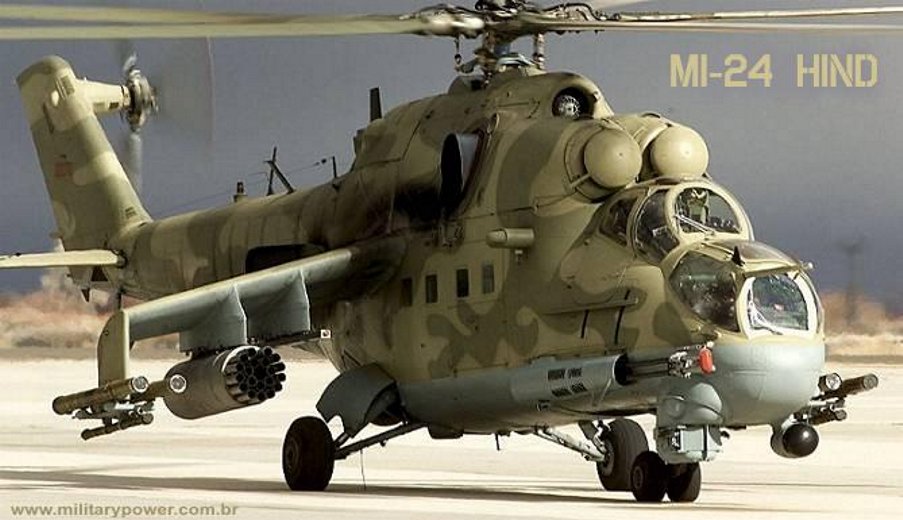Mil Mi-24 HIND ATTACK HELICOPTER, RUSSIA

The Mi-24 attack/transport helicopter is manufactured by the Mil Moscow Helicopter Plant, based in Moscow, Russia. It entered service with the Soviet Union in the late 1970s, and more than 2,500 have been produced. It has been deployed in a number of conflicts including Afghanistan and in Chechnya. The original model (NATO codename Hind-A), designed to carry eight combat troops, was later reconfigured to take on the gunship role (Hind-D). Later versions, Mi-24P and the export Mi-35P, are also armed with anti-tank missile systems for the engagement of moving armoured targets, weapon emplacements and slow-moving air targets. All versions retain the troop transport capability.
The Mi-24 is in service with Russia and countries of the ex-Soviet Union and has been exported to Afghanistan, Algeria, Angola, Bulgaria, Cote-d'Ivoire, Cuba, Czech Republic, East Germany, Hungary, India, Iraq, Libya, Mozambique, Nicaragua, North Korea, Peru, Poland, Vietnam and South Yemen. Recent deliveries include 12 for the Cypriot National Guard. Recent orders include two for Indonesia.
UPGRADES
Russian Army Mi-24s are being upgraded with new avionics including thermal imagers. Other upgrade packages are available, including that of Denel/Kentron of South Africa which includes Eloptro infrared sighting systems and Kentron Mokopa anti-tank missiles, and IAI Tamam which has HMOSP (helicopter multi-mission Optronic Stabilised Payload) with FLIR, TV and autotracker, embedded GPS (global positioning system) and cockpit multi-function displays.
The "Visegrad Four" - Czech Republic, Hungary, Poland and Slovakia - signed an agreement in February 2003 to jointly upgrade up to 105 Mi-24D/V helicopters to NATO standards. This agreement has been abandoned. However, two Polish Mi-24s are being upgraded to NATO standard as prototypes. In February 2004, BAE Systems was selected as integrator for the avionics systems, which will include an integrated electronic warfare suite.
In December 2005, Bulgaria signed a contract for the upgrade of 12 Mi-24 helicopters to a team led by Lockheed Martin and Elbit.
DESIGN
The design of the Mi-24 is based on a conventional pod and boom, with a five-blade main rotor and three-blade tail rotor. It has retractable tricycle nose-wheel landing gear.
The two crew (pilot and weapons operator) are accommodated in tandem armoured cockpits with individual canopies and flat, bulletproof glass windscreens. The main cabin can accommodate eight troops or four stretchers.
WEAPONS
The helicopter has six suspension weapon units on the wingtips. The Mi24D (Mi-25) and the Mi-24V (Mi-35) are equipped with a YakB four-barrelled, 12.7mm, built-in, flexibly mounted Machine gun, which has a firing rate of 4,000-4,500 rounds per minute and a muzzle velocity of 860m/s. The Mi-24P is fitted with a 30mm, built-in, fixed gun mount; the Mi-24VP with a 23mm, built-in, flexibly mounted gun.
The Mi-24P and Mi-24V have four underwing pylons for up to twelve antitank missiles. The Mi-24V (Mi-35) is armed with the Shturm anti-tank guided missile system. Shturm (NATO designation AT-6 Spiral) is a short-range missile with semi-automatic radio command guidance. The 5.4kg high-explosive fragmentation warhead is capable of penetrating up to 650mm of armour. Maximum range is 5km.
The Mi-24V can also carry the longer-range Ataka anti-tank missile system (NATO designation AT-9), as can the Mi-24P. The Ataka missile's guidance is by narrow radar beam, and the maximum range of the missile is 8km. The average target range is between 3-6km. The target hit probability of the Ataka missile is higher than 0.96 at ranges 3-6km. The missile has a shaped-charge 7.4kg warhead, with a tandem charge for penetration of 800mm thick explosive reactive armour.
All Mi-24 helicopters can also be armed with rockets and grenade launchers.
AVIONICS
The Mi-24D is equipped with the KPS-53A electro-optical sighting pod. The most recent Mi-24V and P variants have a digital PNK-24 avionics suite and multifunction LCD cockpit displays, and Geofizika ONV1 night-vision goggles, along with NVG-compatible cockpit lighting. They are fitted with the Urals Optical and Mechanical Plant GOES-342 TV/FLIR sighting system and a laser rangefinder. Countermeasures include infrared jammer, radar warner and flare dispensers.
ENGINES
The helicopter is powered by two Isotov TV3-117VMA turboshaft engines, developing 2,200shp each. The air intakes are fitted with deflectors and separators to prevent dust particle ingestion when taking off from unprepared sites. An auxiliary power unit is fitted.
The internal fuel capacity is 1,500kg, with an additional 1,000kg in an auxiliary tank in the cabin or 1,200kg on four external tanks. The fuel tank has self-sealing covers and porous fuel tank filler for increased survivability, and the exhaust is fitted with infrared suppression systems.